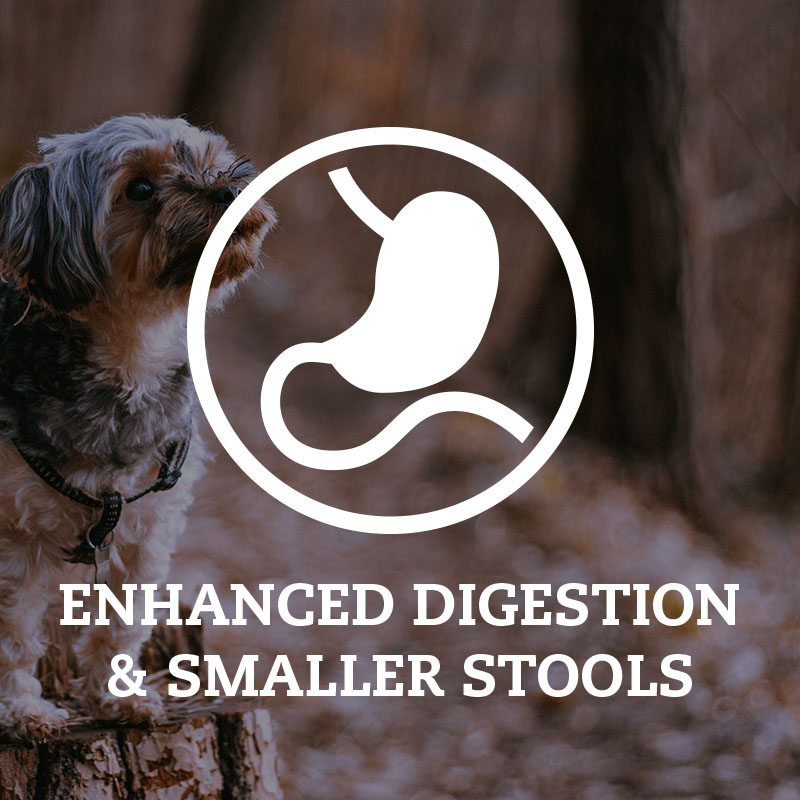Diet is a major driver of the gut microbiome composition and function(1). A recent study showed that dogs fed raw had an improved overall health score compared to those fed a high-quality kibble, suggesting an improvement in all aspects of health(2). Raw protein and fat have a higher digestibility, than their cooked counterparts, due to their unprocessed format, making raw suitable for dogs suffering from chronic digestive issues.
Although bacteria diversity will vary between dogs, the dominant bacteria in the canine gut include Bifidobacterium, Enterobacteriaceae, and Fusobacterium, which are species adapted to the digestion of meat(3,4). In fact, raw fed dogs hosted a higher abundance of Enterobacteriaceae in their gut compared to kibbled fed dogs, which are geared towards meat digestion(5,6).
Diet can impact the fermentation of non-digestible carbohydrates by commensal bacteria in the colon, resulting production of short chain fatty acids (SCFAs), most importantly, acetate, propriate and butyrate)(7). Relative amounts of butyrate production were increased in dogs fed raw compared to dry(8). In fact, butyrate seems to be the preferred energy source of colonocytes, and its benefits for gut health are suggested by its anti-inflammatory and antineoplastic properties(8).
Digestibility
Protein, crude fat and energy digestibility has been found to be higher in dogs fed a raw diet compared to those on a kibble diet(6). This same study found that dogs fed raw produced a lower volume of faeces than those on kibble and demonstrated a higher faecal health score, which was linked to improved digestibility. The shift in dietary fat content from kibble to raw can result in higher abundance of the commensal bacterium P. hiranonis in raw fed dogs, which converts primary bile acids (PBAs) to SBAs(7). Its role is very important for modulating the gut microbiota, influencing digestion and potentially impacting overall health.
Research found multiple differences between the faecal microbiome of dogs on raw against those on kibble, though it is unclear whether this is due to ingredient differences, processing, or both(9). Whilst an increased presence of IgA and IgG in raw fed dogs could have multiple implications, the increased presence of Intestinal Alkaline Phosphatase (IAP) in raw fed dogs demonstrates better intestinal health(9). This is because it’s a critical enzyme in intestinal health and barrier function. Raw fed dogs also had increased counts of gluconic acid, which may exert a prebiotic effect due to the stimulation of lactic acid and butyrate production(10).
High Temperature Processing
Whilst gentle cooking can increase the bioavailability of vegetables by breaking down tough plant fibre, the opposite occurs with meat protein. Heat processing can negatively impact amino acids through protein-crosslinking, proteolysis and Maillard reactions (MRs)(3). High cooking temperatures increase the mutagenicity of animal and plant protein, by inducing nonenzymatic reactions (MR) between protein and sugars, making proteins aggregate and crosslink. This reaction makes meat more difficult to digest. Thus, the higher the cooking temperature and the prolonged cooking time, the more MRs occur, reducing protein digestibility.
See our gut health chapters linked below:
- The Dog’s Digestive System: Go With Their Gut
- The Gut Microbiome and It’s Links to Overall Health: Healthy Gut, Healthy Dog
- Common Gut Conditions in Dogs
- How Diet Impacts Gut Health: Food For Thought

References
- Alessandri, G. et al. (2020) ‘Catching a glimpse of the bacterial gut community of companion animals: a canine and feline perspective,’ Microbial Biotechnology, 13(6), 1708-1732. Available here
- Hiney, K. et al. (2021) ‘Clinical health markers in dogs fed raw meat-based or commercial extruded kibble diets,’ Journal of Animal Science, 99(6). Available here
- Brady, C. (2021) Feeding Dogs: The Science Behind The Dry Versus Raw Debate
- Sandri, M. et al. (2017) ‘Raw meat based diet influences faecal microbiome and end products of fermentation in healthy dogs,’ BMC Veterinary Research, 13(65). Available here
- Schmidt, M. et al. (2018) ‘The fecal microbiome and metabolome differs between dogs fed Bones and Raw Food (BARF) diets and dogs fed commercial diets.’ PLoS One, 13(8), 0201279. Available here
- Bermingham, E. N. et al. (2017) ‘Key bacterial families (Clostridiaceae, Erysipelotrichaceae and Bacteroidaceae) are related to the digestion of protein and energy in dogs,’ PeerJ, 2(5), 3019. Available here
- Herstad, M. V. et al. (2017) ‘A diet change from dry food to beef induces reversible changes on the faecal microbiota in healthy, adult client-owned dogs,’ BMC Veterinary Research, 13(147). Available here
- Goncalves, P. and Martel, F. (2013) ‘Butyrate and Colorectal Cancer: The Role of Butyrate Transport,’ Current Drug Metabolism, 14, 994-1008. Available here
- Hiney, K. et al. (2024) ‘Faecal microbiota composition, serum metabolomics, and markers of inflammation in dogs fed a raw meat-based diet compared to those on a kibble diet,’ Frontiers in Veterinary Science, 11. Available here
- Tsukahara, T. et al. (2002) ‘Stimulation of butyrate production by gluconic acid in batch culture of pig caecal digesta and identification of butyrate-producing bacteria,’ The Journal of Nutrition, 132(8), 2229-2234. Available here
Lucy James, BSc (Hons) Bioveterinary Science
Looking to enhance your pet’s diet? Take a look at Cotswold RAW’s range of raw dog food and raw cat food, including raw meaty bones, dried treats, and puppy food.

